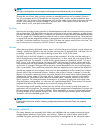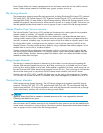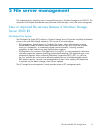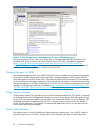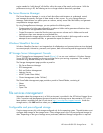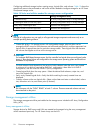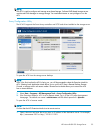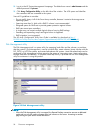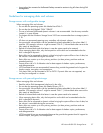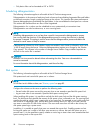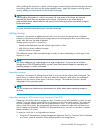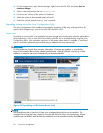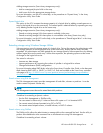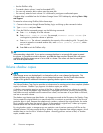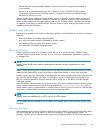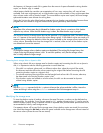
• It may take a few moments for the Remote Desktop connection session to log off when closing Disk
Management.
Guidelines for managing disks and volumes
Storage servers with configurable storage
When managing disks and volumes:
• Do no t alter the operating system disk labele d Local Disk C:.
• Do not alter the disk labeled “DON’T ERASE.”
• The use of software RAID-based dynamic volumes is not recommended. Use the array controller
instead; it is more efficient.
• The largest disk that Windows Storage Server 2003 can accommodate from a storage system is
2TB.
• HP does not recommend spanning array controllers with dynamic volumes.
• Use meaningful volume labels with the intended drive letter embedded in the volume label, if
possible. (For example, volume e: might be nam e d “Dis k E:.”) Volume labels often serve as the
only means of identification.
• Record all volume labels and drive letters in case the system needs to be restored.
• When managing basic disks, only the last par tition on the disk can be extended unless the
disk is changed to dynamic.
• Basic disks can be converted to dynamic without bringing the system offline or loss of data, but
the volume is unavailable during the conversion.
• Basic disks can contain up to four primary partitions (or three primary partitions and one
extended partition) .
• Format drives with a 16 K allocation size for best support of shadow copies, per formance,
and defragmentation.
• NTFS formatted drives are recommended, because they provide the greatest level of support for
shadow copies, encryption, and compression.
• Only basic disks can be formatted as FAT or FAT32. Dynamic disks are not supported, nor
can they be configured in a cluster.
Storage servers with pre-configured storage
When managing disks and volumes:
• Read the online Disk M anag em ent help found in the utility.
• Do not alter the operating system disk labeled Primary OS C:.
• Use meaningful volume labels with the intended drive letter embedded in the volume label, if
possible. (For example, volume F: might be named “Disk F:.”) Volum e labels often serve as the
only means of identification.
• Record all volume labels and drive letters in case the system needs to be restored.
• When managing basic disks, only the last par tition on the disk can be extended unless the
disk is changed to dynamic.
• Basic disks can be converted to dynamic without bringing the system offline or loss of data, but
the volume is unavailable during the conversion.
• Basic disks can contain up to four primary partitions (or three primary partitions and one
extended partition) .
• Format drives with a 16 K allocation size for best support of shadow copies, per formance,
and defragmentation.
• NTFS formatted drives are recommended because they provide the greatest level of support for
shadow copies, encryption, and compression.
HPProLiantDL380G5StorageServer
57



